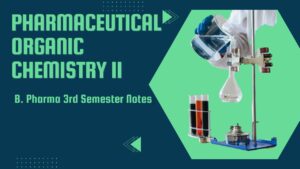Pharmaceutical Organic Chemistry II – B. Pharma 3rd Semester Notes PDF

Scope: Pharmaceutical Organic Chemistry deals with general methods of preparation and reactions of some organic compounds. The reactivity of organic compounds is also studied here. The syllabus emphasizes mechanisms and orientation of reactions. The chemistry of fats and oils is also included in the syllabus.
Objectives: Upon completion of the course the student shall be able to
1. write the structure, name, and the type of isomerism of the organic compound
2. write the reaction, name the reaction, and the orientation of the reactions
3. account for the reactivity/stability of compounds,
4. prepare organic compounds
Course Content:
General methods of preparation and reactions of compounds superscripted with an asterisk (*) to be explained
To emphasize definition, types, classification, principles/mechanisms, applications, examples, and differences
Pharmaceutical Organic Chemistry UNIT I
Benzene and its derivatives
A. Analytical, synthetic, and other evidence in the derivation of the structure of benzene, Orbital picture, resonance in benzene, aromatic
characters, Huckel’s rule
B. Reactions of benzene – nitration, sulphonation, halogenation- reactivity, Friedelcrafts alkylation- reactivity, limitations, Friedelcrafts acylation.
C. Substituents, the effect of substituents on reactivity and orientation of mono-substituted benzene compounds towards electrophilic substitution reaction
D. Structure and uses of DDT, Saccharin, BHC, and Chloramine
Pharmaceutical Organic Chemistry UNIT II
Phenols* – The acidity of phenols, the effect of substituents on acidity, qualitative tests, Structure and uses of phenol, cresols, resorcinol, naphthols
Aromatic Amines* – Basicity of amines, the effect of substituents on basicity, and synthetic uses of aryl diazonium salts
Aromatic Acids* – Acidity, the effect of substituents on acidity, and important reactions of benzoic acid.
Pharmaceutical Organic Chemistry UNIT III
Fats and Oils
a. Fatty acids – reactions.
b. Hydrolysis, Hydrogenation, Saponification, and Rancidity of oils, Drying oils.
c. Analytical constants – Acid value, Saponification value, Ester value, Iodine value, Acetyl value, Reichert Meissl (RM) value – significance and principle involved in their determination.
Pharmaceutical Organic Chemistry UNIT IV
Polynuclear hydrocarbons:
a. Synthesis, reactions
b. Structure and medicinal uses of Naphthalene, Phenanthrene, Anthracene, Diphenylmethane, Triphenylmethane and their derivatives
Pharmaceutical Organic Chemistry UNIT V
Cyclo alkanes*
Stabilities – Baeyer’s strain theory, limitation of Baeyer’s strain theory, Coulson and Moffitt’s modification, Sachse Mohr’s theory (Theory of strainless rings), reactions of cyclopropane and cyclobutane only
Pharmaceutical Organic Chemistry 3rd sem Notes PDF
Pharmaceutical Organic Chemistry 2 Short Notes:
Benzene and its Derivatives:
Benzene is an aromatic hydrocarbon consisting of a ring of six carbon atoms with alternating single and double bonds.
Benzene and its derivatives are widely used in pharmaceutical organic chemistry for the synthesis of various drugs.
Benzene derivatives include compounds such as toluene, aniline, chlorobenzene, and nitrobenzene, which serve as building blocks for drug synthesis.
Phenols:
Phenols are organic compounds that contain a hydroxyl group (-OH) attached to an aromatic ring.
Phenols have antiseptic and disinfectant properties and are used in pharmaceutical formulations.
Examples of phenols include phenol itself, cresols, and chloroxylenol.
Aromatic Amines:
Aromatic amines are organic compounds in which an amino group (-NH2) is attached to an aromatic ring.
They are important in medicinal chemistry as they are used in the synthesis of drugs, dyes, and other organic compounds.
Examples of aromatic amines include aniline, toluidine, and chloroaniline.
Aromatic Acids:
Aromatic acids are organic compounds containing a carboxylic acid group (-COOH) attached to an aromatic ring.
They are used in pharmaceuticals as intermediates in drug synthesis or as active ingredients themselves.
Examples of aromatic acids include benzoic acid, salicylic acid, and cinnamic acid.
Fats and Oils:
Fats and oils are esters of fatty acids and glycerol, and they are important in pharmaceuticals and formulations.
They serve as excipients in drug formulations to improve stability, solubility, and drug release.
Examples of fats and oils include triglycerides derived from vegetable sources, such as olive oil and soybean oil.
Polynuclear Hydrocarbons:
Polynuclear hydrocarbons are organic compounds composed of multiple fused aromatic rings.
They are found naturally in coal tar and are used in the synthesis of various drugs and dyes.
Examples of polynuclear hydrocarbons include naphthalene, anthracene, and phenanthrene.
Cycloalkanes:
Cycloalkanes are saturated hydrocarbons that form a closed ring structure.
They are used in pharmaceutical organic chemistry as starting materials for the synthesis of drugs.
Examples of cycloalkanes include cyclohexane, cyclopentane, and cyclopropane.
PHARMACEUTICAL ORGANIC CHEMISTRY -II (Practical)
I. Experiments involving laboratory techniques
Recrystallization
Steam distillation
II Determination of following oil values (including standardization of reagents)
Acid value
Saponification value
Iodine value
III Preparation of compounds
Benzanilide/Phenyl benzoate/Acetanilide from Aniline/ Phenol/Aniline by acylation reaction.
2,4,6-Tribromo aniline/Para Bromo acetanilide from Aniline/Acetanilide by halogenation (Bromination) reaction.
5-Nitro salicylic acid/Meta di nitro benzene from Salicylic acid / Nitro benzene by nitration reaction.
Benzoic acid from Benzyl chloride by oxidation reaction.
Benzoic acid/ Salicylic acid from alkyl benzoate/ alkyl salicylate by hydrolysis reaction.
1-Phenyl azo-2-napthol from Aniline by diazotization and coupling reactions.
Benzil from Benzoin by oxidation reaction.
Dibenzal acetone from Benzaldehyde by Claison Schmidt reaction
Cinnammic acid from Benzaldehyde by Perkin reaction
P-Iodo benzoic acid from P-amino benzoic acid
Pharmaceutical Organic Chemistry Recommended Books (Latest Editions)
1. Organic Chemistry by Morrison and Boyd
2. Organic Chemistry by I.L. Finar , Volume-I
3. Textbook of Organic Chemistry by B.S. Bahl & Arun Bahl.
4. Organic Chemistry by P.L.Soni
5. Practical Organic Chemistry by Mann and Saunders.
6. Vogel’s text book of Practical Organic Chemistry
7. Advanced Practical organic chemistry by N.K.Vishnoi.
8. Introduction to Organic Laboratory techniques by Pavia, Lampman and Kriz.

1 thought on “Pharmaceutical Organic Chemistry II – B. Pharma 3rd Semester Notes PDF”
Comments are closed.